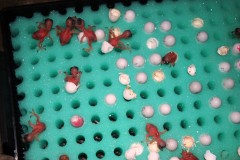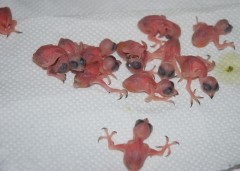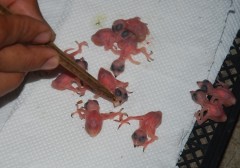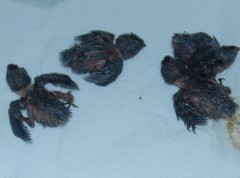Feb 26, 2010
Caviar of the East - Building the Population
Building up the critical mass naturally takes time. We decided to speed things up a little by incubating eggs and acclimatising them to the micro-climate at our farm from hatchlings.

Hatching out in a mere 16 days, not 20 + days as recorded in most books. Almost failed as knowing the incubation period is critical to a successful hatch. However daily observation and experience permitted us to have a successful hatch inspite of misinformation from books and various blogs (one blog recommended an incubation temperature of 40 celcius. That will most likely 'cook' the embryo).
In the brooder at 35 celcius.
Hand feeding starts 8 hours after hatching.
Update:
Feathering after 14 days
Feathering after 21 days
16:12 Posted in Blog | Permalink | Comments (5) | Tags: swiftlet farming, walit, walet, swiftlets, aerodramus fuciphagus, aerodramus maximus













Comments
WOW! congrats! you feeding 'em with what mr wong? flies? =)
Posted by: haslinda | Feb 27, 2010
Kerengga eggs!
Posted by: HS | Feb 27, 2010
Dont you think you are going against Nature. The babies mother must be very sad losing their rights to mother the babies.
Posted by: LL | May 27, 2010
Hi,
Don't know whether mother birds feel 'sad' when they lose their eggs before embryos develop. Nature have allowed birds to lay a replacement egg everytime an egg is lost. If a bird have a clutch of 2 and we remove one, the bird will lay another to replace.
Since no embryo has developed there is no bond and when we place the egg in another bird's nest, the mum will willingly accept it, even if the mum is a different species.
But if we place a chick in a different nest, the chick will invariably be killed.
Posted by: HS | May 27, 2010
hi boss...like your post...u feed them kerengga eggs not insects???
or anai-anai eggs???just only that boss???
Posted by: angah | Dec 02, 2011
The comments are closed.